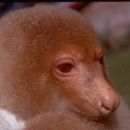en
names in breadcrumbs


Perception Channels: tactile ; chemical
Other Physical Features: endothermic ; bilateral symmetry
Key Reproductive Features: gonochoric/gonochoristic/dioecious (sexes separate); sexual
The Phalangeridae are a family of mostly nocturnal marsupials native to Australia, New Guinea, and Eastern Indonesia, including the cuscuses, brushtail possums, and their close relatives. Considered a type of possum, most species are arboreal, and they inhabit a wide range of forest habitats from alpine woodland to eucalypt forest and tropical jungle. Many species have been introduced to various non-native habitats by humans for thousands of years.[2]
Phalangerids are relatively large, compared with other possums. The smallest species, the Sulawesi dwarf cuscus, is cat-sized, averaging 34 cm (13 in) in length, while the largest, the black-spotted cuscus, is around 70 cm (28 in) long, and weighs 5 kg (11 lb). Besides the large size, other key features distinguishing phalangerids from other possums include the presence of bare skin on at least part of the tail, and low-crowned molar teeth. They have claws on the fore feet, but none on the hind feet, although these do have an opposable first toe to help grip onto branches. Additionally, in all but one species, both the first and second digits of the fore feet are opposable. Their fur is typically dense or woolly, and may be grey, black, or reddish-brown, often with spots or stripes.[3]
Most phalangerids are folivores, feeding primarily on leaves. Like some similar species, they have a large cecum to ferment this highly fibrous food and extract as much nutrition as possible. Their teeth, though, are not as highly adapted to this diet as other possums, and they also eat fruit, and even some invertebrates. The only exception to these general rules is the ground cuscus, which is carnivorous, and is also less arboreal than other phalangerid species.[3] The dental formula of phalangerids is:
Gestation in phalangerids lasts 16–17 days in those species so far studied. The females have a well-developed pouch, and typically raise only one or two young at a time, less than many other possums. The adults are typically solitary, defending territories marked by scent-gland spray, odiferous saliva, urine, or dung.[3]
Most possums conserve the functions of the epipubic bones. The exception is Trichosurus, which remarkably among marsupials has shifted the hypaxial muscles from the epipubic to the pelvis, employing a more placental-like breathing, having lost the benefits of the epipubic in regards to lung ventilation. In general, these possums are more terrestrial than other members of this group, and resemble terrestrial primates in some respects.[4]
This classification is based on Beck et al. (2022).[5] The listing for extant species is based on The Third edition of Wilson & Reeder's Mammal Species of the World (2005),[1] except where the Mammal Diversity Database and IUCN agree on a change.
Blust (1982, 1993, 2002, 2009)[8][9][10][11] reconstructs the form *kandoRa cuscus for Proto-Central–Eastern Malayo-Polynesian (i.e., the reconstructed most recent common ancestor of the Central–Eastern Malayo-Polynesian languages), but the validity of this reconstruction is doubted by Schapper (2011).[2]
Schapper (2011) shows that reconstructed forms for cuscus are in fact quite diverse, and cannot be reconstructed to Proto-Central–Eastern Malayo-Polynesian. Other names for cuscus are:[2]
Other local names for the cuscus are:[2]
The Phalangeridae are a family of mostly nocturnal marsupials native to Australia, New Guinea, and Eastern Indonesia, including the cuscuses, brushtail possums, and their close relatives. Considered a type of possum, most species are arboreal, and they inhabit a wide range of forest habitats from alpine woodland to eucalypt forest and tropical jungle. Many species have been introduced to various non-native habitats by humans for thousands of years.